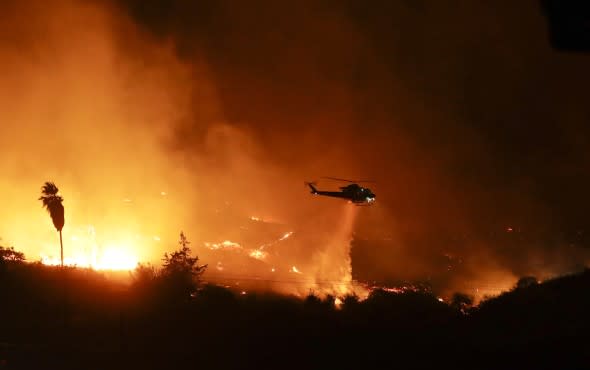California's 2017 wildfire season to rank among most destructive, costly on record
California's 2017 wildfire season will go down as one of the worst in the state's history, with a season that lasted longer than normal and featured multiple record-shattering blazes.
From Jan. 1, 2017, through Dec. 31, 2017, over 9,000 fires burned more than 1.2 million acres, an increase from the previous year which brought 6,986 fires burning around 564,000 acres, according to Cal Fire.
The total acreage in 2017 included nearly 300,000 acres burned solely by Thomas Fire, which grew to the largest wildfire in state history in late December.
The Thomas Fire, which remains active as of Jan. 3, has burned 281,893 acres and is over 90 percent contained. The blaze began back on Dec. 4 in Ventura County and exploded in growth thanks for strong Santa Ana winds. It has destroyed over 1,000 structures and claimed two lives.
While the Thomas Fire became the largest California wildfire in recorded history, it was also the seventh-most destructive, in terms of number of structures destroyed, according to Cal Fire. However, two months prior to the Thomas Fire, a new record was set for most destructive wildfire in state history.

Flames rise from the remains of a house that burned down in Santa Rosa, Calif., Monday, Oct. 9, 2017. Wildfires whipped by powerful winds swept through Northern California, sending residents on a headlong flight to safety through smoke and flames as homes burned. (AP Photo/Jeff Chiu)
In October, the Tubbs Fire, which charred over 36,000 acres in the state's wine country, destroyed 5,643 structures and claimed 22 lives in Sonoma and Napa counties. The number of structures destroyed from the Tubbs Fire alone is more than half of the 10,780 total structures lost to wildfire in 2017 statewide. The 22 deaths also make it the third deadliest wildfire on record in California.
Along with the Tubbs Fire, multiple other destructive blazes damaged critical infrastructure and forced evacuations from Oct. 8 through Oct. 31 across seven counties. Some of the most jarring damage photos came from the city of Santa Rosa, which lost entire sections of neighborhoods.
President Donald Trump approved major disaster declarations in October for the Northern California fires and then again on Jan. 2 for the Southern California fires. The disaster declarations will provide federal assistance for recovery efforts in the state.
The North Bay fires resulted in $9 billion in claimed losses, according to the California Department of Insurance. Across the state, more than 5,700 residential properties were listed as total losses, while over 15,000 residential properties were listed as partial losses.
AccuWeather's long-range team of meteorologists predicted an above-normal fire season for California, but a season this terrible would've been hard to imagine, according to AccuWeather Meteorologist Evan Duffey.
California's wetter-than-normal winter in 2016-2017 proved to be a double-edged sword. While frequent storms helped eradicate the state's five-year drought, the wet weather allowed ample vegetation to grow and subsequently serve as fuel for wildfires in the spring and summer.
"Winter precipitation allows for abundant growth of new vegetation in spring," Duffey said. "This vegetation, however, rarely makes it to fall without curing due to California's hot and dry summers, and so abundant fuels were available for wildfires. Then as fall came around, long-lasting high pressure systems to the east provided the opportunity for offshore wind events which often lead to or worsen fire activity."
Cal Fire's northern units began summer fire preparations in late May, while the fire season for southern units began in mid-June. While winter preparation is already underway in the northern regions, the southern units have not yet transitioned to winter preparedness.

A helicopter drops water over a wildfire Thursday, Dec. 7, 2017, in Bonsall, Calif. (AP Photo/Gregory Bull)
While October's fires wreaked havoc in Northern California, Southern California become ensnared in several firestorms in December, an unusual month for such dramatic fire activity.
December, which is usually when California's wet season is beginning, featured persistently dry weather along with frequent Santa Ana wind events which provided the opportunity for several fires to experience explosive growth.
Additional fires across Southern California in December included the Creek Fire (over 15,600 acres and 60 residences destroyed), Rye Fire (over 6,000 acres and six structures destroyed) and Lilac Fire (4,100 acres and 157 structures destroyed).
On a national level, the United States Forest Service spent a record $2.4 billion on fire suppression during the fiscal year, which lasted from Oct. 1, 2016, to Sept. 30, 2017. That number is about $800 million more than the approximately $1.6 billion Congress appropriated to the agency. In the previous fiscal year, the forest service spent just over $1.6 billion, according to the National Interagency Fire Center.
The Los Angeles Times reported that Cal Fire spent nearly $700 million fighting fires through early December and the longer fire season has forced state officials to spend more taxpayer money as the firefighting staff expands.
Due to losses in homes, business closures, firefighting and rehabilitation costs and several other factors, AccuWeather predicted in early December that the total cost from the California wildfire season in 2017 will reach $180 billion.
